| |
Member Search
By User Name
By State
|
|
|
|
|
|
|
|
 | How to Overcome “Buck Fever” |  | | Webster’s Dictionary defines “Buck Fever” (a noun dating back to 1841) as “nervous excitement of an inexperienced hunter at the sight of game”. I fair to differ with this definition in that the word “inexperienced” should probably be deleted form the definition as a little buck fever can always be found in all of us hunters (if we’re honest with ourselves). Buck fever is basically the adrenalin within your body that causes you to miss a deer, and is a subject that you hear a lot about around the camp in jest; but is one subject that you don’t hear a lot about how to resolve. It is the rush you experience when you first see that big buck and you know you will probably get a shot at him! Symptoms of buck fever vary from hunter to hunter. Some hunters have buck fever so bad that they hyperventilate. Others have the shakes so bad that it is impossible to get a good aim at a deer much less make an accurate shot. Buck fever has changed in me over the years. When I first started hunting and saw a shooter deer, my heart would seem as though it was going to explode! Then later in life and many deer later, this became only a little heavy breathing as if I was in high altitude. I now can watch deer as long as I want and not have any buck fever symptoms, except when I make the decision that the deer I’m looking at is a shooter and I’m going to take him, then the fever starts! At this point I start to have a slight increase in breathing, but I have learned to control it so I can make an accurate shot. If you love hunting as much as I do, then you only have two chances of ever getting rid of buck fever; a slim chance and no chance at all! The key is controlling buck fever instead of it controlling you. I can remember the first time one of my son’s slung an arrow at a wild boar and he missed the hog, he looked at me and said “Dad, I’m sick, I’m bad sick! There is something wrong with me; I think I have a bad disease…” I said “Why do you think you’re sick?” and he said “because I’m shaking all over; look at my hands, they shake like an old man”. I said “Son, you’ve just got a bad case of buck fever; everybody that likes to hunt gets buck fever”. He then asked how do you get rid of it enough that you can get the hog; I told him that you just have to tell yourself to get over it; that your not going to get this hog if you’re not determined enough and don’t concentrate on your strategies like where and when you’re going to shoot; you have to be so determined that you put aside your buck fever. About another hour later my son got a chance to shoot at another wild boar. It was interesting to see the change in his character as he obviously took my advice. He never took his eyes off the hog, he hunkered down, set that jaw, and he had such a determined look on his face that you could almost read the words “dead hog” on his forehead! Needless to say he made an excellent shot and bagged the first wild boar of his life. In summary, there is no magical formula to cure buck fever, but the best approach to buck fever is self_control; learning how to best control buck fever that works for you. It seems to me that if you have hunted so long that buck fever would be missing as part of the hunting experience, then it would seem like there would be no need to hunt at all. Buck fever is a part of why you hunt in the first place! | |  | Return To Top |  |
 | Aging Whitetail Deer (odocoileus virginianus), A Simple Approach |  | | The only accurate field method of aging deer is by an examination of the teeth on the lower jaw (either side). There are other ways such as size, hair color, antler development, and other characteristics of aging deer, none of which are accurate indicators of age. The fawn is the only exception as long as spots on the coat are still present (3 to 4 months old). For purposes of managing a deer population, the simplest approach is to only classify deer in half year increments. Deer are aged by either tooth replacement (1/2 and 1 ½ year age classes) or by tooth wear (2 ½ to 5 ½ + year age classes). The following are age classes of whitetail deer. ½ year old age class: If a deer has less than 6 teeth, the deer is classified as a ½ year old deer or fawn. A fawn will usually have 4 or 5 teeth on the lower jaw (the front teeth called incisors are not needed in aging deer by age class). The first three teeth are premolars (baby teeth) and these three teeth will be replaced as the deer enters the 2 ½ year age class. The fourth tooth from the front is a molar, and this will be a key tooth in aging deer in older classes as this tooth is the oldest tooth that a deer will have and therefore will show the most wear. 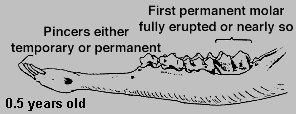
1 ½ year old age class: If a deer has 6 lower jaw teeth, the deer is at least 1 ½ years old or older. The 1 ½ year old deer has three peaks called cusp on the third tooth (a premolar) from the front of the deer’s mouth. The remaining 4th, 5th, and 6th tooth will be very sharp and will show little or no wear. It will take a little time to recognize where one tooth ends and another tooth begins as the teeth are very close together. 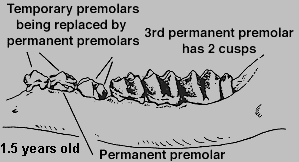 2 ½ year old age class: If a deer has 6 lower jaw teeth, and there are 2 cusp on the third jaw tooth from the front, the deer is at least 2 ½ years old or older. The 2 ½ year old deer has 6 sharp permanent lower jaw teeth (the first three premolars have been lost and replaced with three molars). The fourth jaw tooth (the first molar a deer ever had, the oldest tooth) has sharp peaks or crest called lingual (next to the tongue) crest and the enamel (white) on the lingual crest is well above the narrow dentine (dark brown center that is sandwiched between the enamel of the lingual crest). The last cusp on the last (6th tooth) tooth will have a shallow cup shape. 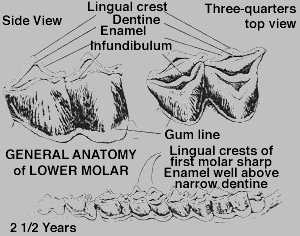
3 ½ year old age class: Same as the 2 ½ year old deer except that the fourth lower jaw tooth shows more wear and has a blunt lingual crest and the lingual crest dentine is wider than the enamel. Also the last cusp on the last tooth will be flattened with a concave top. 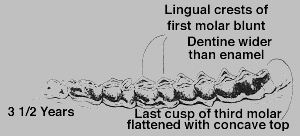 4 ½ year old age class: Same as the 3 ½ year old deer except that the fourth lower jaw tooth shows more wear and the lingual crest dentine is twice as wide as the enamel. Also the last cusp on the last tooth is worn such that the top slopes toward the cheek. 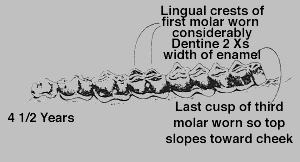 5 ½ + year old age class: Same as 4 ½ year old deer except that the replaced premolars are moderately worn and the fourth lower jaw tooth shows more wear such that the lingual crests are worn away. See chart or more specific on aging beyond 5 ½, but for management purposes, most wildlife managers lump all deer older that 5 ½ years into the 5 ½ + year old age class. 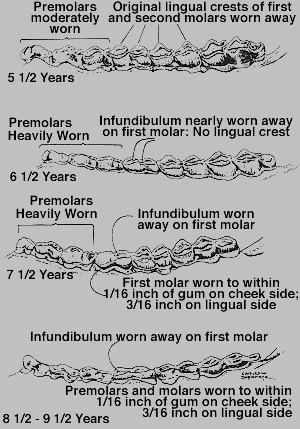
| |  | Return To Top |  |
 | Kidney Fat Index Collection Procedure |  | | The Kidney Fat Index (KFI) is a method of determining the health of a deer herd. The KFI is expressed in a percentage, the higher the percentage the healthier the deer herd. To be of value as a health index, the fat deposit must be properly quantified and interpreted. Before the deer is gutted, remove both kidneys with fat attached from the rear of the stomach cavity. If you do not have time to do the evaluation now, then freeze the kidneys in a labeled plastic bag until you have time to process them at a later date. Trim the fat from both ends of the kidney and discard the fat (see diagram). Remove the remaining fat by cutting into the kidney covering, and peep off the kidney covering with the fat attached. Then weigh (a food scale would be adequate) and record both kidneys and the kidney fat separately. The KFI is calculated by dividing the weight of the fat by the weight of the kidneys and multiply by 100 and record as a percent. 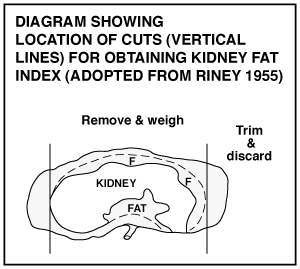 The KFI should not be used to compare deer herd health between different times of the year such as between spring and fall. Consistency should be used from year to year in the collection of deer kidneys and kidney fat. The function of fat deposition in deer must be understood to properly interpret deer herd health based on fat indices. The basic function of fat deposits in deer is to store reserve energy during periods of energy surplus for later use for periods of energy deficiencies. Also fat retention by bucks differs from that of does, i.e. bucks will tend to retain fat in the summer months whereas does may be delayed 2 to 3 months because of the energy demands of lactation (milk production). Deer herd health evaluation between different times of the year using fat indices must be done with caution because of the normal seasonal changes in fat deposits taking place within deer. Mechanisms within deer turn on and off the fat deposition process at certain periods to insure the long_term survival of the deer herd. Quantities of deposited fat must be interpreted relative to the seasonal appropriate amounts to be expected under a variety of nutritional conditions. The primary application of KFI is interpreting area differences within the same season and yearly differences within the same area and season. Therefore be consistent in the timing of KFI collections from year to year but vary the exact timing based on any environmental differences that need to be considered. | |  | Return To Top |  |
 | Habitat Manipulation for Whitetail Deer |  | | Whitetail deer (odocoileus virginianus), like other wildlife species, have specific habitat requirements for optimum carrying capacity for any given land. In simple terms, Deer need 50% brush, 25% woodland, and 25% cultivation on any given amount of land in order to thrive. Most hunters and wildlife enthusiast believe that the best way for deer to thrive is to develop food plots throughout their land or hunting lease. However, most wildlife biologist agrees that food plots certainly help but do not make as big of an impact as generally believed. Starting with the aforementioned requirement needs of deer, it would obviously be a good idea to do enough clear cutting of woodlands to produce the biggest habitat needs of deer, and that is to produce brush land. Most people take a dim view of clear cutting timber, but in areas where clear cutting is practiced, the deer populations are much higher than in areas that are not clear cut. Since deer are basically a browse animal, the brush produced by the clear cutting provides foliage in the warmer months which supplies deer with the protein levels they need to produce muscle that they have lost during the previous winter months (especially bucks which eat very little during the rutting period); and provides winter buds for the colder months that helps carry the deer through the winter with good nutrition (even when the ground is covered with snow). The next habitat manipulation item to take that would produce the next best results for deer proliferation is to develop a good woodland management plan. Most all wildlife seems to produce better with variety. Variety is said to be the spice of life, and so it is with whitetail deer. Contrary to most forestry timber management plans of even age trees, the optimum woodland management for deer would be to have trees from the age of 1 year old to the age 80 years old. To produce a diversified woodland, a very well implemented selective timber cut would need to be done. Within this deer habitat management plan, besides the additional foliage browse that this plan produces, the mast that is produced provides the deer with the fat levels that the deer need to carry them through the winter months. However, most land managers don’t have the luxury of managing their lands to the ultimate maximum habitat requirements of whitetail deer; therefore the most common applicable habitat manipulation is food plot development. Food plot development can be a very expensive deer habitat manipulation practice, especially if the goal is to produce the last 25% of the deer requirements. Even though the cost can be high enough to be a limiting factor in providing the 25% cultivation, most wildlife managers rarely get enough food plots developed simply because the land that they are managing does not lend itself to cultivation. So what can feasibly be done to produce a good food plot development plan? The first thing to do is to get soil samples for soil testing food plot areas. This is usually done by inserting a slotted metal tube in the ground about 7 inches deep, and then removing the soil by pushing the soil down the metal tube into a small plastic bag. A reconnaissance map (showing the complete tree and plant types of the land) of the area should be used to mark the soil sample locations in order to treat the food plot area with the prescribed fertilizer and/or lime. The soil samples should be marked as indicated on the map and then brought to a facility that does soil testing. One of the best organizations to do soil testing is the Department of Agriculture County Extension Service. This is a free service and they do a good job of testing and explaining the results. The County Extension Service usually have the “T” shaped slotted metal tubes to lend that make it easy to extract the soil samples. Seed selection would be next important item for a good food plot development plan. One of the most palatable deer cultivated plants is winter wheat. Wheat is not expensive when compared to other plant types such as clovers and brassicas or commercial food plot mixes. Plowing is not needed for wheat to maintain maturity such as corn and other grains, and it is planted in the fall which gives the deer that extra variety and nutrition that they need in the winter months. To increase the variety level of food plots, oats is an excellent choice to mix with winter wheat. Oats are also inexpensive when compared to other highly advertised food plot mixes and perennial plants. Other plant types can be added to the food plots to increase the variety level. Any legumes such as Austrian winter peas can be added similar to adding spice to a cooking recipe. However, these plant types are more expensive and would normally be planted as the smallest portion of the food plot mix. To expand food plot development without a lot of expense is to try to set back the natural habitat plant succession. This can be done with such habitat manipulation practices as control burning (usually done in mid February), bush hogging, and disking. Each of these habitat manipulation methods produces somewhat different results but basically sets back the natural plant succession such that plants called “early invaders” are produced. This includes various legumes that are very palatable to deer. Food plots usually provide pseudonatural browse for deer when planted in small but many plots as apposed to large but fewer plots. This can best be done by taking a fallow field, and making disk strips about 3 to 4 disk wide, or dividing the field into three equal sections and disking one of the sections. Each year rotate to another third section leaving the other two sections uncultivated, and on the forth year, start the rotation process over again by disking the first third section of the field. This practice reduces cost, naturally sets back the plant succession to provide natural food for deer, and provides the needed cover for deer that they would not get if the entire field was disked each year. Given the optimum habitat requirements of 50% brush, 25% woodland, and 25% cultivation for managing whitetail deer, it is most likely that the cultivated section will get the most attention. However, food plot development does not offer the best method of deer habitat improvement, therefore it would be better to tend to the other 75% of the deer habitat needs if possible and not to increase the cultivation beyond 25% in order to keep the deer herd from getting too dependent on food plot sources in case of crop failure. | |  | Return To Top |  |
|
|
|